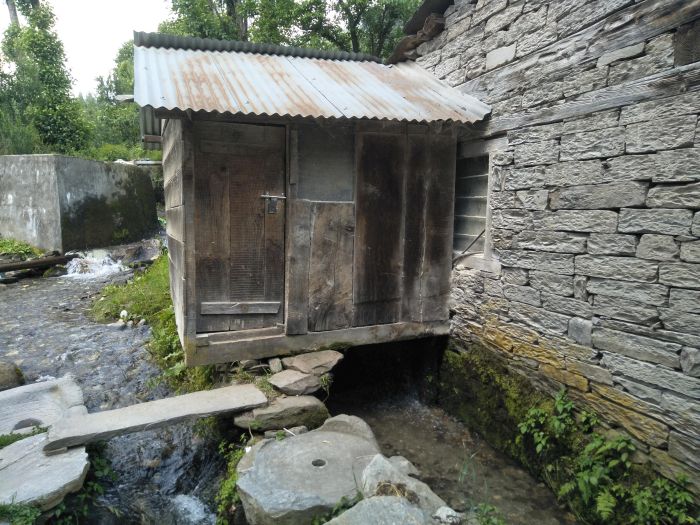Manali: There was a time when a Water Mill locally known as ‘Gharat’ (watermill) was an essential feature of the village landscape of Kullu valley. In those days of backbreaking manual labour, a Gharat (water mill) harnessing the power of flowing water of river, stream or an irrigation channel was a living example of mankind’s feeble attempt at technological solutions and use of mental ingenuity at solving the perennial problem of grinding and de-husking enough grains to satiate its hunger.
Many a member of the older generation would vouch for the fact that a Gharat owner had a better social status in the village hierarchy for he could afford both food grains and money as a service charge on grinding. Their sons and daughters had a better chance of finding a suitable match in those times when famines were a constant recurrence. Gharats had such a great contribution to the village economy.
For hundreds of years the Gharats have been a part and parcel of agricultural economy and a source of livelihood. The upper valley of Kullu had about fifty functional Gharats on a distributary of river Beas.
Gharats also find a space in our art and literature. The Gharats have always remained a fine example of use of local technology. The Gharatis (Person who rens the gharata) on their own create feeding channels diverting water of the rivers, rivulets ,brooks and streams which are found in abundance in the hills. The Gharats are also built of locally available material like mud, stones and timber. Surprisingly even mill stones are chiseled out of the locally available boulders found on river beds by the Gharatis themselves. They are also skilled in chiseling grooves on mill stone which gets worn out due to continuous use and affects grinding efficiency of the Gharat. Even the equipment is made out of locally available wood which requires constant repair.
In order to save Gharats from extinction it is essential that a census be organized so as to gauge the importance and significance of the Gharats. As per the traditional wisdom, the flour obtained from Gharats is of better quality and nutrition. Housewives in the rural areas prefer flour obtained from Gharats as having better texture and better Rotis especially of maize can be made out of it. This is largely due to sustained rate of milling and cold grinding of the grains. As a result of less heat, the nutrients are preserved and better quality of product is obtained. Just as mustard oil is marketed citing health benefits of cold pressing (Kachi Ghani), similarly flour obtained from Gharats can be marketed as having better health benefits. Surely the discerning consumer of the urban areas will be ready to pay an extra rupee for the better quality products.
Water mills harness renewable resources i.e. running water which otherwise would be of no use. It would be interesting to find out the savings in fossil fuels which are substituted by the Gharats. If scientifically calculated the same can be helpful in earning carbon credits as is provided in the environmental protocols.
However with the passage of time and onslaught of industrialization, the Gharats are fast losing the ground to Atta Chakkis powered by electricity. Each Atta Chakki license issued by District authorities sounds the death knell of Gharats. So much so that Gharatis have been pushed out of business and the gharats have come to a grinding halt as a majority of them have been abandoned for the want of customers. A visit to many a streams and rivulets of Manali region tell a tale of abandoned watermills, untended irrigation Khuls , Grinding stones scattered here and there.
The Ministry of New and Renewable Energy has focused its attention on renewable sources and has recognized the contribution of watermills in providing a sustainable source of energy in hilly regions. The existing talent pool of the Engineering department and research institutions can chip in by upgrading the existing watermills and introducing low cost designs having ease of operations. Flourishing watermills are integral part of our agricultural economy and cultural heritage.
Managlu Ram, owner of a watermill in Sarsai, while sreaking to Hill Post disclosed that the people these days hardly have any grains for grinding most of the agriculture fields are converted to apple orchards by the villagers. He added that I can’t even earn my daily wage from the water mill and our upcomiong generation is not interested in carrying forwards any more.

Sanjay Dutta, an engineer by qualification but is a journalist by choice.
He has worked for the premier new agency Press Trust of India and leading English daily Indian Express.
With more than a decade of experience, he has been highlighting issues related to environment, tourism and other aspects affecting mountain ecology.
Sanjay Dutta lives in a village close to Manali in Kullu valley of Himachal.







Wonderful article about the vanishing watermills,appreciate the amount of information givèn in the preservation of the same.
I can create a gharat to be used at home in cities !
have a look at the gharats project by IIT Mandi students.
http://www.iitmandi.ac.in/istp/projects/2015/Gharats_Kamand_6.html